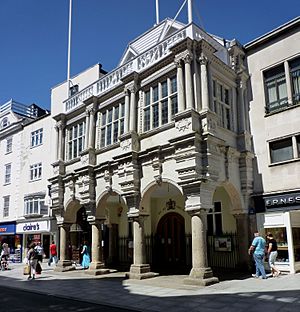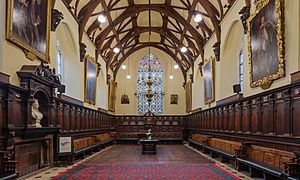Exeter Guildhall facts for kids
Quick facts for kids Exeter Guildhall |
|
|---|---|
 |
|
| Location | Exeter, Devon |
| Built | 1470 |
| Architectural style(s) | Ornate Italian style |
|
Listed Building – Grade I
|
|
| Designated | 29 January 1953 |
| Reference no. | 1103905 |
| Lua error in Module:Location_map at line 420: attempt to index field 'wikibase' (a nil value). | |
The Exeter Guildhall is a very old and important building in Exeter, Devon, England. For over 600 years, it has been the main place where the city's government makes decisions. Most of the building is from the Middle Ages. Its fancy front was added in the 1590s, and the inside was fixed up a lot in the 1800s. It is a special building called a Grade I listed building.
Contents
History of the Guildhall
How Old is the Guildhall?
The Guildhall has been in its current spot since at least the 1300s. It might even have been there since the late 1100s. We also know that a group called a "guild" was in Exeter by the year 1000. Their hall was probably in this same place too. Because of this, some people say it is the oldest government building in England that is still being used today.
Building the Guildhall
The building you see now was built between 1468 and 1470. Its front was changed between 1593 and 1596. This cost £789, which was a lot of money back then! The new front was built in a fancy Italian style.
The part that sticks out over the sidewalk was finished in 1594. It has four strong granite columns. Above these columns are decorated stone supports made from Beer stone. The top floor is also made of Beer stone. It has 16 smaller pillars around large windows. These windows have both vertical (mullions) and horizontal (transoms) bars. During repairs, people noticed that the stone used to be painted cream. It had red and blue details, and the pillars were covered in gold.
Inside the Guildhall
The city's stocks (a device used to punish people) used to be under the front part of the building. The beautifully carved oak door was made in 1593 by a local carpenter named Nicholas Baggett. This door leads to a small room, then to the main council chamber. This room seems to be from 1468 to 1470. However, it was greatly repaired in Victorian times. The arched roof with seven sections is original. Its main wooden supports rest on carved stone figures of strange animals.
In 1685, a judge named Judge Jeffreys held court here. A large chandelier hangs from the center of the roof. It was made in 1789. Except for this chandelier and the roof, everything else inside is from the Victorian era. This includes the colored glass windows, the balcony, the furniture, and the stone floor, all added in 1863. The old wooden wall panels were also fixed up in 1887. Above the fireplace, there is a statue of Queen Victoria.
Old Prisons and Records
Under the main council chamber, there is a cellar from the early 1300s. This used to be a prison called the "pytt of the Guyldhall." In the 1500s, another prison for women was built on the ground floor at the back. It was used until 1887. In 1858, a room was built above this prison to keep the city's important papers. Later, it was used as a room for the jury during trials.
The Guildhall in the 1900s
The front room above the entrance was once the council chamber. In 1903, it was changed into the mayor's parlour. This is where the mayor meets visitors. In 1911, the council chamber was used for an election petition. This happened after the second general election of 1910. The Guildhall is also a special historical site and became a Grade I listed building in 1953.
For most of the 1900s, the Guildhall was where the local government of Exeter met. It continued to be the main government building even after the city of Exeter became larger in 1974. The mayor's parlour had a plaster ceiling from around 1800. A new, similar ceiling was put in its place in 1986.
Today, the Guildhall is still used for many important city events. These include official parties, banquets for the mayor, and some City Council meetings. It is also used for other meetings, exhibitions, and sometimes as a court.
City Symbols
The main chamber has many wooden panels. On these panels, you can see many shields with symbols. These symbols represent different people who held important jobs in the City Corporation. They show a lot about the history of symbols in Devon. These symbols were first written about by Thomas Westcote around 1637. Later, Rev. Frederick T. Colby added more details in his book, The Heraldry of Exeter.


